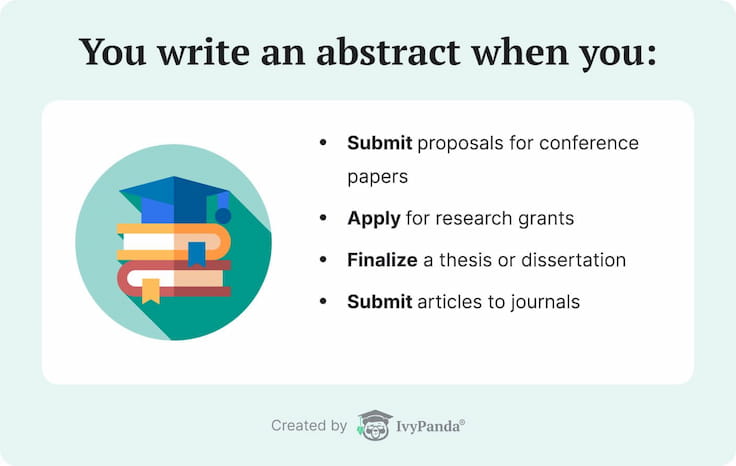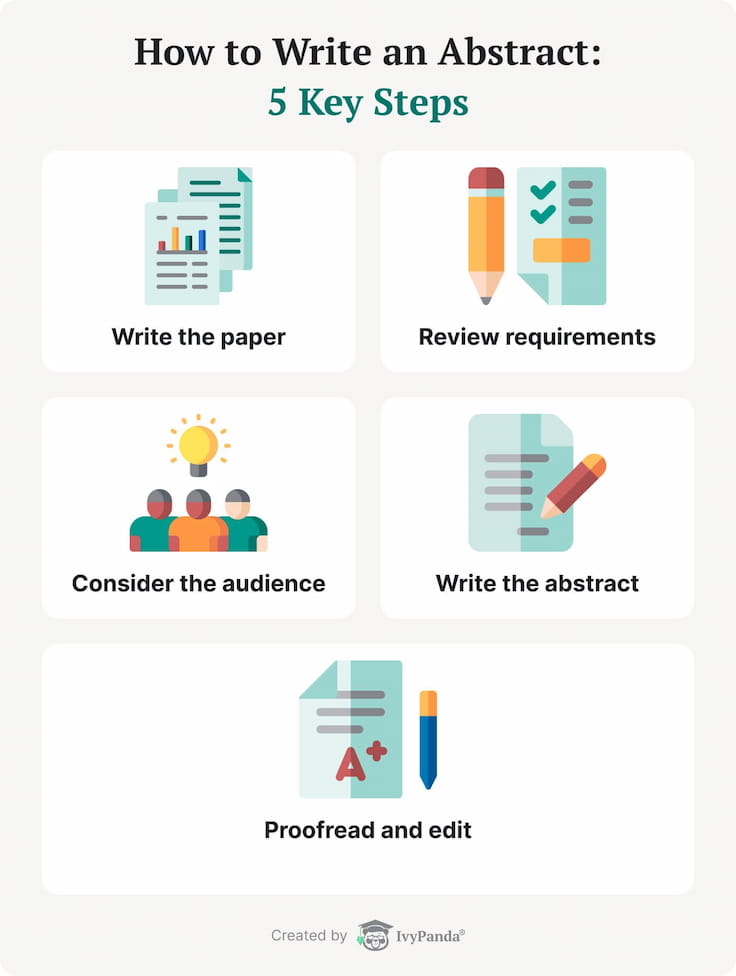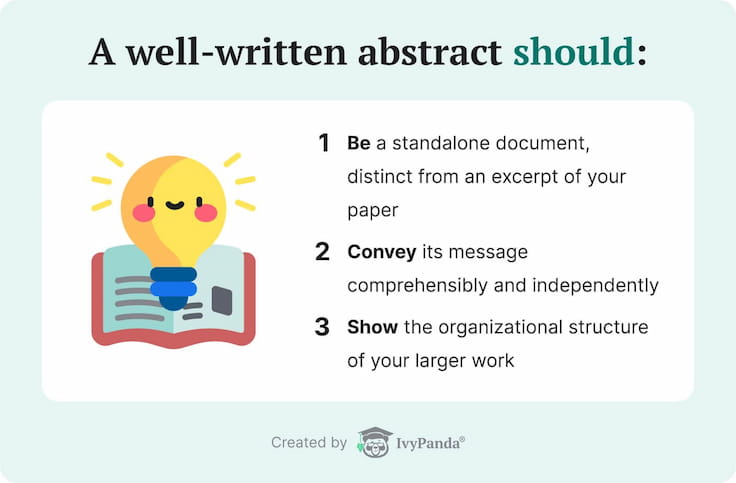Free Abstract Generator for Research Papers
🚀 Meet Our Abstract Generator for Research Papers
The abstract provides a brief overview of the research assignment. So, this part gives a general assessment of the work and encourages the reader to explore it further. Almost every student dealt with the difficult task of condensing their research results into several hundred words. But that’s not a problem anymore!
We used artificial intelligence to make a tool that will make your academic life more enjoyable. You can get an excellent example of an abstract specifically for your research paper in minutes. To do this, you need to specify the reason for the research, the problems, and the goals. Also, we recommend mentioning the methodology and your findings to ensure the outcome is accurate. After that, the AI abstract maker will do the rest for you!
Key Reasons to Use Our Online Abstract Generator
Students juggle various assignments and obligations. Research papers are among the most challenging tasks they have to complete. What makes them so difficult is the sheer volume of information and study involved. Dealing with large amounts of material often leaves students drained and incapable of summarizing their work correctly.
Our abstract generator for research papers makes this process more straightforward thanks to several factors:
📃 What Is an Abstract?
Abstracts provide short summaries of larger works, including research papers and dissertations. Readers scan them to decide whether or not they wish to continue reading the rest of the paper. In about 150–200 words, you should state the problem and provide the research goal, results, implications, and used methods.

One should write research abstracts only after the rest of the work is ironed out and ready. While this part of research may seem insignificant, students should take the time to write the abstract well. Doing so lets them identify any flaws in the research methodology and results.
Types of Research Paper Abstracts
Many students believe that abstracts come only in one type. In reality, there are several versions of summaries used in academic circles.
- Critical Abstract.
These are the most extensive abstracts, at around 450 words. Unlike other entries on this list, they encourage deep analysis: for example, a discussion about the validity or reliability of their studies. It’s mostly used in social science research. - Descriptive Abstract.
This format is quite similar to informative abstracts but much shorter. On average, this type is only 100 words long and covers the main focus of the studies. Descriptive summaries offer no conclusions or recommendations for further research. - Highlight Abstract.
Students rarely get to use this type, as its primary goal is to get the reader’s attention. Highlight abstracts don’t helpfully summarize papers. Instead, they concentrate on the unique parts of the research, such as its results and conclusions. - Informative Abstract.
This is the most common type used by researchers and writers. It provides primary information about research concepts, methodology, findings, and recommendations. Sometimes, informative research abstracts have keywords listed at the bottom, but this practice is mainly reserved for professional publications.
✍️ How to Write an Abstract in 5 Steps
Despite the incredible versatility of our abstract generator, it’s still important to learn how to make abstracts on your own. We’ve dedicated this part of the guide to the five steps of writing these summaries. So, these instructions will help you create an abstract for any academic paper.

- Write the paper. To create an abstract, you first need a research paper. Create an outline of the study detailing the problem and methods you’ll use to address it. Explain the research methodology, state what information can be extracted from it, and show how the findings apply to the overall field of study.
- Review paper requirements. Once you’re done with the draft, review the criteria provided by the educational institution. Use the supporting documents with instructions, as they can clarify the requirements for the work's style, formatting, and length. Different disciplines require specific styles, so read this information carefully.
- Consider the audience. When working on an abstract, it’s crucial to identify who will be reading it afterward. For example, students often adjust their language to reach the general public and not only their respective professors.
- Write the abstract. Now, write the abstract based on the provided requirements. Use the body of the research to summarize the problem, explain the methods used in the paper, and show what their results were. Finish the summary by telling why your findings are valuable to the study field and what can be done in further research.
- Iron it out. Like with all writing pieces, it's essential to review the abstract and check if it has all the necessary components. The text should be easy to follow, cover all points, and be informative. As the abstract creates the first impression, make it a good one.
Abstract Formats: MLA & APA Styles
Abstract types aren’t the only things students should look out for. In academic settings, several formatting styles detail how the text should look on paper. The majority of US colleges use two popular methods: MLA and APA. Here, we discuss how abstracts look in each of them.
🫣 7 Mistakes You Should Avoid When Writing an Abstract
Writing abstracts is a pretty straightforward process. But it doesn’t mean that everybody is immune from making mistakes, especially after spending days toiling away on a research paper.
There are seven common errors everybody should check before submitting an abstract.

- Making it too long. A summary should concisely describe the whole paper. Avoid repetition and details that have little to do with the research.
- Using chopped-up sentences. Ensure that your paper contains only complete sentences. It makes the work more professional and easier to comprehend.
- Adding too much technical jargon. Keep things simple so that anyone reading the abstract understands what it’s about. It will also make more people check out your paper.
- Not correcting the text. Sometimes, students want to finish a work without editing it too much. Take the time and comb the document for errors and factual mistakes.
- Failing to explain the significance of the research. The first couple of sentences should give readers a clear understanding of why the study is essential.
- Using the wrong tense. It’s recommended that abstracts be written in the past tense. Some academic institutions won’t accept papers with improperly written abstracts.
- Too many adjectives and hyperboles. You aren’t writing a 19th-century novel but an academic paper. The work should reflect that, so avoid using too many literary devices.
We hope you’ve found this article interesting and helpful in your academic pursuits. We also suggest taking a look at our guide for creating an excellent research paper. If you have any more questions about the art of writing abstracts, check out the FAQ section below.
❓ Research Abstract Generator – FAQ
- It’s written for the right audience.
- It's in the past tense and third person.
- Stands alone on the page.
- Has keywords and critical references.
- Reason for writing it and the importance of the research.
- Problematics the work attempts to solve.
- Methodology behind the study.
- Results backed by specific data.
- Practical and theoretical applications of the findings.
Updated:
🔗 References
- What Exactly is an Abstract? – Regents of the University of Michigan
- Abstract and Keywords Guide. – American Psychological Association
- Writing an Abstract. – The University of Melbourne
- Six Steps to Write an Abstract. – The University of Alabama
- How To Write an Abstract in 7 Steps (With an Example). – Indeed
- MLA Formatting: How Do I Do: An Abstract. – Warner Pacific University Library
- Abstracts. – The Writing Center, University of North Carolina at Chapel Hill